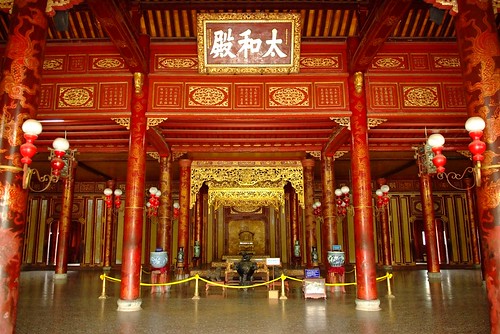Thai Hoa palace was the nerve
center for the Emperor’s court during its heyday. Built in 1805 by Emperor Gia
Long, Thai Hoa palace was first used in 1806 for the emperor’s coronation.
Directly in line with the Ngo Mon
Gate along the Hue Citadel’s central axis, Thai Hoa palace can be reached after
walking 330 feet across a bridge known as the Trung Dao (Central Path) which
crosses a pond known as the Thai Dich (Grand Liquid Lake).
Immediately after crossing the
bridge, you’ll step onto the Great Rites Court, where mandarins assembled to
pay homage to the emperor.

The lower half, further away from
the Thai Hoa palace, was reserved for village elders and lower-ranking
ministers. The upper half of the court was reserved for high-ranking mandarins;
you can still see the foot-high steles on either side of the court that dictate
where each mandarin rank should stand relative to the Thai Hoa palace.
Thai Hoa palace was the nerve
center for the Emperor’s court during its heyday. Built in 1805 by Emperor Gia
Long, the Throne Palace was first used in 1806 for the emperor’s coronation.
Over the years, Thai Hoa palace became the preferred setting for the Empire’s
most important ceremonies, like the Coronations of Emperors and Crown Princes,
and receiving foreign ambassadors. High meetings of state were also conducted
at the Thai Hoa palace.
The Thai Hoa palace was built to
accommodate such pomp and circumstance: the building is 144 feet long, 100 feet
wide, and 38 feet tall, supported by lacquered-red columns entwined with gilded
dragons. Over the throne hangs a carved board bearing Chinese characters
reading “Thai Hoa palace-Palace of Supreme Harmony”.
The insulation and acoustics of
the Thai Hoa palace are amazing for a building its age. The Thai Hoa palace
enjoyed cool temperatures in the summer, and warm temperatures during the
winter season. And anyone standing at the exact center of the Palace – where
the throne was normally placed – could hear sounds from any point in the
palace.

















